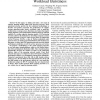Free Online Productivity Tools
i2Speak
i2Symbol
i2OCR
iTex2Img
iWeb2Print
iWeb2Shot
i2Type
iPdf2Split
iPdf2Merge
i2Bopomofo
i2Arabic
i2Style
i2Image
i2PDF
iLatex2Rtf
Sci2ools
130
Voted
TC
2010
2010
Model-Driven System Capacity Planning under Workload Burstiness
In this paper, we define and study a new class of capacity planning models called MAP queueing networks. MAP queueing networks provide the first analytical methodology to describe and predict accurately the performance of complex systems operating under bursty workloads, such as multi-tier architectures or storage arrays. Burstiness is a feature that significantly degrades system performance and that cannot be captured explicitly by existing capacity planning models. MAP queueing networks address this limitation by describing computer systems as closed networks of servers whose service times are Markovian Arrival Processes (MAPs), a class of Markov-modulated point processes that can model general distributions and burstiness. In this paper, we show that MAP queueing networks provide reliable performance predictions even if the service processes are bursty. We propose a methodology to solve MAP queueing networks by two state space transformations, which we call Linear Reduction (LR) and...
Information Technology | MAP Queueing Networks | Performance | Queueing | Software Engineering | TC 2010 |
Related Content
| Added | 21 May 2011 |
| Updated | 21 May 2011 |
| Type | Journal |
| Year | 2010 |
| Where | TC |
| Authors | Giuliano Casale, Ningfang Mi, Evgenia Smirni |
Comments (0)

